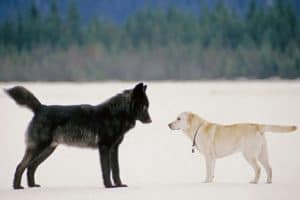The contrast between domesticated dogs and wild wolves is striking. While both belong to the same family, their behaviors are shaped by vastly different environments and experiences. Understanding these differences can not only satisfy your curiosity but also enhance your relationship with your canine companions.
Domesticated dogs exhibit more social and cooperative behaviors, shaped by years of human interaction, while wolves tend to display instincts tied to survival and independence. There’s plenty more to explore about how these fascinating creatures differ in ways that can surprise you, so keep reading to unlock the secrets behind their behaviors!

Social Structure and Packs
Wolves are renowned for their structured pack dynamics, which play a crucial role in their survival. Each wolf knows its position, contributing to a cohesive unit that thrives in the wild. At the top are the alpha wolves, usually a breeding pair that maintain order and make critical decisions for the group. The social hierarchy extends down, ensuring that every wolf understands its role in hunting, rearing pups, and defending territory.
Contrastingly, domesticated dogs exhibit a more relaxed social structure that doesn’t revolve around strict hierarchies. While they still maintain social bonds and can form groups, the relationships are often more fluid and less defined. Dogs look to humans for leadership, which alters their natural instincts and behaviors, making them more adaptable to various family dynamics. This shift has resulted in dogs being able to get along with a broader array of canine companions than the typically territorial wolves. Furthermore, when dogs do form packs, the organization can be non-hierarchical, with friendships and alliances forming based largely on personalities rather than rank.
Understanding these differences in social structures can shed light on a dog’s behavior in a home environment versus a wolf’s behavior in the wild. While both species have strong social instincts, their approaches are markedly distinct, highlighting the influence of domestication on canine behavior.
Communication Styles
The way wolves and dogs communicate is fascinating and highlights their behavioral differences. Wolves primarily rely on vocalizations, body language, and subtle signals to convey messages within a pack. For example, their howls serve multiple purposes: they can call the pack together, signal territory, or simply foster social bonds. Body language is more pronounced in wolves, with posture, ear position, and facial expressions all playing critical roles in communication. A low tail between the legs can indicate submission, while a high stance could display confidence or aggression.
Dogs, on the other hand, have adapted their communication style to suit life alongside humans. While they still use similar vocalizations like barking, growling, and whining, they often employ these sounds to seek attention or express needs rather than convey detailed social information. Their body language remains key, but it’s tailored for human understanding. For instance, a wagging tail can indicate excitement, while a dog staring with soft eyes might express affection or trust—something that translates well to human emotions.
One unique insight is the role of visual cues in dog communication. Dogs can read and respond to human gestures and facial expressions, something wolves generally do not do. For instance, a dog might learn to understand when you’re pointing or looking at something, making them highly trainable companions.
These communication styles are shaped by the different environments in which these species have evolved. Wolves rely on subtle, nuanced cues in the wild, whereas dogs benefit from a more expressive and adaptable approach in human households, emphasizing their role as companions and helpers.
Instincts and Hunting Behaviors
Wolves are masterful hunters, relying on a complex set of instincts honed over centuries for survival. They hunt in packs, using coordinated strategies that involve tracking prey, communicating through howls, and attacking in a unified front. This teamwork and focus are crucial for bringing down large animals like deer or elk, ensuring not just the individual’s survival, but the pack’s as a whole.
Domesticated dogs, on the other hand, have shifted their focus from survival hunting to playful instinct-driven behaviors. While they still exhibit some hunting traits—like chasing small animals or playing tug-of-war—they’re more about engaging with their environment than seeking sustenance. For many pet dogs, these behaviors are often just that: fun games rather than necessities. This difference highlights the evolutionary path both species have taken, with dogs adapting to life alongside humans, often yielding their instincts to fit this new role.
Interestingly, even breeds developed for specific tasks, such as hunting or herding, exhibit their wild ancestors’ traits in a diluted manner. A Labrador Retriever might retrieve a thrown ball with the enthusiasm of a wolf catching prey, but this playful act is rooted in social interaction rather than survival.
Learning and Training Approaches
The learning processes of dogs and wolves are shaped by their environments and interactions with others, but they couldn’t be more different. Dogs are incredibly adaptable learners, thriving on social cues from humans. They pick up commands through repetition and positive reinforcement, forming strong bonds with their owners. That’s why you often see dogs responding eagerly to cues like “sit” or “stay”—they associate these commands with rewards, which fosters their motivation to engage in our world.
Wolves, however, rely primarily on instinctual learning. Young wolves learn by observing their pack members, picking up essential skills for survival through trial and error. They don’t rely on humans for guidance or rewards; instead, their education comes from nature. This innate learning is crucial for mastering hunting techniques, social hierarchies, and territorial behaviors.
Unique Insight : A fascinating aspect of this difference is how it affects temperament. Dogs’ ability to read human emotions and behaviors has made them incredibly trainable, whether for service roles or just as family pets. In contrast, wolves maintain a certain wildness and independence, which makes them less suited for domestic life.
So, while you could train a dog to deliver your slippers, a wolf in the same setting would likely remain distant, valuing freedom over obedience. This ultimately underscores the distinct paths these two species have taken, molded by their environments and needs.
Play Behavior Differences
The way play unfolds between dogs and wolves reveals key insights about their social structures and behaviors. Dogs tend to engage in more varied play with humans and other dogs. Their play often incorporates elements of fetch, tugging, and even more complex games that involve human interaction. This is largely influenced by their domestication, which encourages a playful bond with humans.
On the other hand, wolf play is primarily about social bonding within the pack. It’s often rough-and-tumble, mirroring manipulative behaviors that can mimic hunting techniques. Wolves engage in sparring and chasing, but this play also serves a purpose—it helps teach pups essential skills they’ll need for survival.
Socialization plays a pivotal role here: dogs that experience positive interactions during play are generally more adaptable and friendly, leading to a well-rounded temperament. In contrast, wolves have fewer opportunities for such socialization outside their natural groups. They rely on kinship ties to dictate their play, making it more structured and less variable.
Wolves also showcase a unique element to their play: it’s often hierarchical. Play behaviors can indicate status within the pack, with more dominant wolves controlling the play scenarios. This aspect of play isn’t typically observed in dogs, who often prioritize fun and interaction over hierarchy.
Adaptability to Environments
Domesticated dogs are arguably the champions of adaptability among canines. Living alongside humans, they’ve developed skills to thrive in a wide range of living conditions, from high-rise apartments to sprawling rural farms. This flexibility is tied to their diverse breeds, each having unique traits that suit specific environments.
Wolves, however, are hardwired for specific habitats—their adaptations are rooted in survival. They’re designed for the wild, able to traverse vast landscapes and hunt in packs. Their physical attributes—like endurance and acute senses—are all eons in the making.
Interestingly, dogs have shown an incredible ability to read human emotions and understand cues that help them blend into our lives. This skill not only reflects their adaptability but also highlights a sort of dependence on human companionship for emotional and social fulfillment.
Moreover, dogs have thrived in urban settings due to their versatile diets and trainability. Wolves, in contrast, rely on a prey-based diet and instinctual behaviors that don’t translate well to urban life. Their strong territorial nature makes them less suited for city living, where resources and social structures differ vastly.
In essence, while dogs can adjust to changes in their environment with notable ease and a can-do attitude, wolves remain loyal to their natural instincts and habitats. Each species showcases nature’s incredible adaptability but in entirely different ways, shaped by their unique lifestyles and needs.
Relationship with Humans
The bond between domesticated dogs and humans stands in stark contrast to the often cautious demeanor of wolves when encountering people. Dogs, thanks to thousands of years of selective breeding, have developed a remarkable tendency to seek human companionship and approval. This affectionate nature makes them more attuned to human emotions, enabling many dogs to pick up on cues and signals we often overlook. They wag their tails, seek out touch, and exhibit behavior that mirrors our moods.
In contrast, wolves maintain a natural wariness of humans. This isn’t just a product of instinct; it’s a survival mechanism. Wolves tend to view humans as potential threats, leading them to keep their distance. While they can coexist with humans in certain environments, their innate behavior promotes a more independent existence, relying on their pack for social interaction rather than seeking out humans.
The inherent differences stem from how each species has adapted to their respective environments. Dogs have been bred to cooperate with humans for specific tasks—think hunting, herding, or providing companionship. Wolves, however, thrive in the wild and prioritize their pack structure and survival over human interaction.
Recent Research Findings
Recent studies shine a light on the behavioral disparities between domesticated dogs and wolves, revealing intriguing insights into their social behaviors and communicative abilities. For instance, one study noted that dogs can follow human pointing gestures to find hidden food, a skill that wolves struggle with, showcasing their different evolutionary paths.
Additionally, research from the University of Veterinary Medicine Vienna examined the stress responses of both species. The findings showed that dogs display lower stress levels in the presence of humans compared to wolves, who often exhibited signs of anxiety. This suggests that dogs have physiologically adapted to forge relationships with humans, indicating a more profound emotional attachment.
A unique angle worth noting is the play behavior differences. While both species engage in play, dogs often play in ways that invite human interaction, such as bringing a toy to their owner. Wolves, on the other hand, tend to engage in more physical play with their pack, lacking the same inclination for human involvement. This highlights not just a behavioral difference but a fundamental aspect of social interaction.
Understanding these contrasts offers a glimpse into the complex dynamics between species that share the same ancestry yet have evolved on diverging paths. Each has its unique attributes, shaped by their environments and relationships with humans.
Trivia and Fun Facts
Domesticated dogs and wolves have some fascinating differences when it comes to behavior, shaped by thousands of years of evolution and interaction with humans.
One standout fact: dogs are masters of reading human emotions. Research shows they can interpret human facial expressions and body language much more adeptly than wolves. This stems from their domestication, where communication with humans became crucial for survival and social bonding.
Another interesting angle revolves around social structures. Wolves have a strict hierarchy within their packs, often guided by a dominant alpha. In contrast, dogs usually adapt their social behaviors based on human guidance and may not require a formal structure. This flexibility allows dogs to thrive in diverse environments.
Consider also their play behavior. While both species engage in play, dog play often pertains to mimicry of human activities—fetch is a classic example. Wolves, on the other hand, engage in play that hones their hunting skills. It’s not just fun; it’s essential for learning survival tactics.
Among breeds, variations abound. For example, herding dogs display tendencies reminiscent of wolf pack behaviors but directed towards humans and livestock. This trait showcases how selective breeding has nurtured specific traits in dogs that differ significantly from their wild cousins.
Another intriguing point is their communication methods. Wolves rely on a range of vocalizations—howls, growls, and whines—to express their needs and emotions. Dogs, though they still bark and growl, have evolved to use more subtle cues like tail wagging and body posture to communicate with their human companions.
Lastly, their aggression triggers differ. Wolves show aggression primarily for territorial disputes or when protecting their pack. Dogs, however, can exhibit aggressive behavior in a wider variety of situations, influenced not only by instinct but also by their experiences and interactions with humans.
These differences highlight how domestication has reshaped dog behaviors, allowing them to adapt to human life in ways wolves simply don’t.
Alex, a passionate animal lover, has experience in training and understanding animal behavior. As a proud pet parent to two dogs and three cats, he founded AnimalReport.net to share insights from animal experts and expand his knowledge of the animal kingdom.




